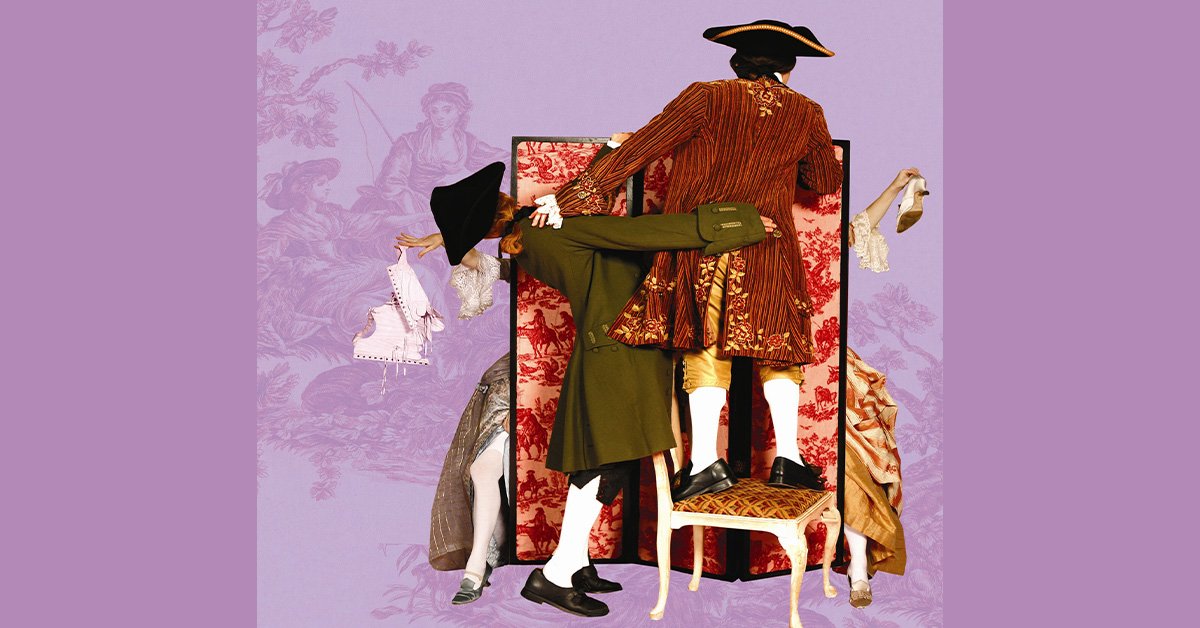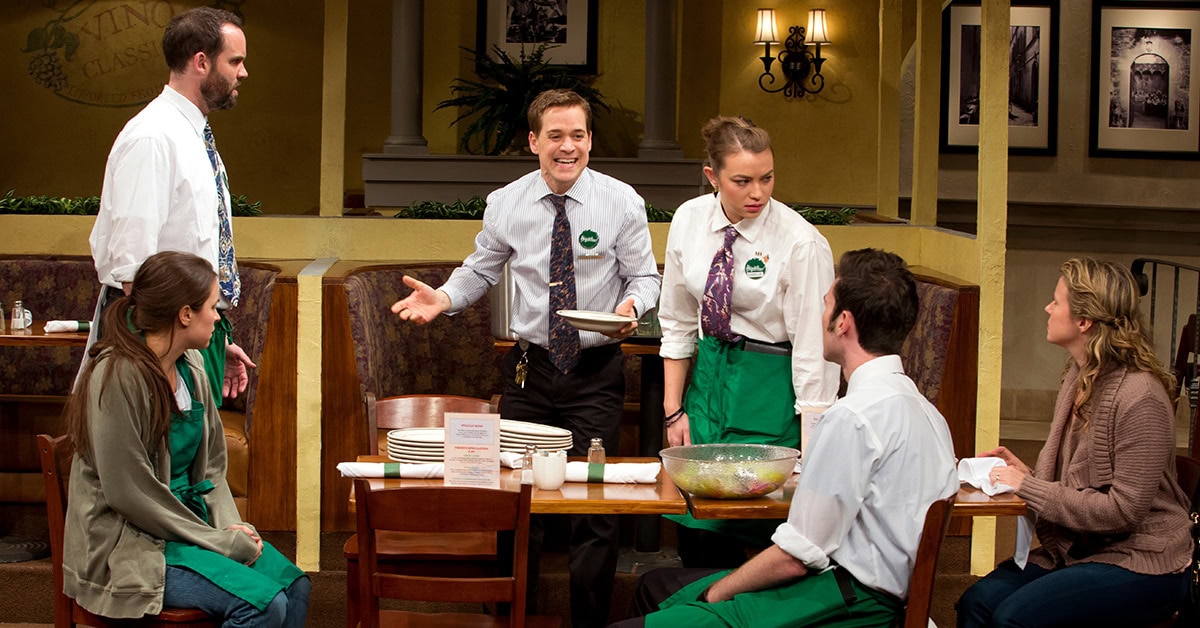
This year marks the 125th anniversary of Thornton Wilder’s birth. To celebrate, we’re taking a look at several of Wilder’s most popular theatrical works. Here, actor/writer/comedian Kevin Stevens recounts his experience performing in a production of The Beaux’ Stratagem (US/UK), George Farquar’s 1707 farce, first adapted by Wilder and later updated by Ken Ludwig.
…
Having the opportunity to perform in The Beaux’ Stratagem was an actor’s dream and an utter pleasure. It’s not often you get the chance to tackle the words of not one, not two, but three prolific and talented playwrights in one piece. The Beaux’ Stratagem, as we know it today, is the result of both Thornton Wilder’s and Ken Ludwig’s adaptations of George Farquhar’s original work. In essence, the version most often performed is the result of a posthumous collaboration on Wilder’s part, which makes it all the more interesting. With its first performance at The Shakespeare Theatre Company in Washington D.C in 2006, this was Wilder’s final play to premiere.
While it is easy to focus on the elements of Restoration Comedy – the legacy of the bawdy genre that was one of only two periods in time where comedy reigned supreme as the most popular form of entertainment – and on Ludwig’s work to bring the piece into the new millennium, Wilder’s fingerprints are all over this play and his voice is clearly felt as a bridge between the most classical and the most contemporary voices.
The source material, written by George Farquhar and originally performed in 1707, was a restoration comedy written at the very tail end of an era when witty, sexually charged, morally loose plays reigned as the top form of entertainment. It tells the story of two London rakes, Archer and Aimwell, who, when their fortunes are almost spent, devise a scheme to marry well by finding a rich young heiress in the country. One will pretend to be a lord, the other a servant, and they will switch roles at every town until one is successful and they can split the dowry after the wedding. After its initial success, the play was rarely performed, and even today is rarely seen outside of educational institutions.
In 1939, Thornton Wilder, coming off the runaway success of Our Town in 1938, was asked by Cheryl Crawford of the Group Theatre to adapt Farquhar’s work for the modern Broadway audience. Loving the style, Wilder accepted. And then war was declared in Europe, and World War II began. Wilder spent the fall of 1939 adapting the piece but by December had run out of steam; he would abandon the project by the new year, having become blocked and unable to write the final act. Whether this had to do with the war is officially unknown. But his next play, The Skin of Our Teeth, would be an allegory about the human condition, and the cyclical nature of history; a play that was clearly a response to a world at war. It’s understandable that a romantic farce might feel somewhat less important at such a period in history. The end result was an unfinished 60-page handwritten manuscript that would molder in the Yale archives until 2004, when the Wilder estate would ask Ken Ludwig to complete the adaptation.
While we have the original 1707 text to compare with the 2006 version, it is easy to see all the adaptational changes made by Ludwig and Wilder, but it is harder to parse the specific differences between 20th- and 21st-century playwrights’ work, as the unfinished manuscript Wilder wrote is not readily available. We do, however, know that Wilder streamlined an overly complicated plot, discarded several characters that were based on 18th-century cultural stereotypes that left a bad taste in his mouth (even in the 1930s), and rewrote the women’s roles to be both more proactive and more comedic. Ludwig would go on to highlight Wilder’s efforts in his adaptation of the final act by including the ladies in the climactic swordfight, giving them some agency in a world where women had little to none.
While I don’t know if the specific words are his, Wilder’s tell-tale style of breaking the fourth wall to directly address the audience, to allow the characters to acknowledge that they are being watched within a play, and to comment upon the events in a more philosophical tone remains well embedded in the final version. The use of the stage manager in Our Town may be his most famous example of this stylistic marker, but it is well used with The Beaux’ Stratagem. While several characters take advantage of a moment alone to break through, it is most frequently used by one of the Beaux, the “servant in disguise” character, Archer. As his actions propel the story forward, he takes time to step outside the story, ponder the moral qualms facing him, and ironically talk about the structure of the play itself. In the original text, these moments appeared only as brief asides. Since they mainly occur in Acts 1-4, it was most likely Wilder who chose to expand them into longer monologues.
I had the pleasure of being cast as Aimwell, one of the two titular beaux, in Nevada Conservatory Theatre’s production of The Beaux’ Stratagem in their 2021-2022 season. Directed by Laura Gordon, this production embraced the Restoration roots of the material in terms of design and concept. Aimwell’s character survived relatively unchanged between the adaptations. Often an adaptation involves a translation of some sort – be it a literal language translation or a transformation between mediums of writing. Wilder’s fascination with comedy and the Restoration period made him a perfect candidate to tackle the unusual task of adapting an English language play into… an English language play. He succeeded in producing a partial script that felt updated enough in relevance and language to appeal to a contemporary audience but maintained the story and style of the original text – the perfect template for Ken Ludwig to complete 70 years later.
Aimwell was joy to play because in many ways he remains a true Restoration ingenu, the young male lover who falls head over heels in love and is transformed from his rakish ways. The style is large, both physically and vocally, and leans into a physical comedy verging on slapstick. Wilder and Ludwig’s adaptation highlights the comedic rivalry between the Beaux as they play their assumed roles of servant and master. The love of language that Wilder exhibited throughout his career is put on full display through this work. Restoration Comedy is fundamentally tied to witticism and the use of heightened language wordplay and was a playground for Wilder’s adaptive imagination. He was able to keep the spirit of the original text while bringing a flair that would appeal to the modern audience. Playing Aimwell, who stayed true to the original restoration ideal, allowed me the opportunity to appreciate not only the heightened style of the genre, but Wilder’s particular facility with language. Wilder’s efforts bring his own unique love of language and flair for commentary to the play, while highlighting what he loved about farcical comedies.
As an actor, understanding both the context of the original story and how it was adapted to remain relevant to a contemporary audience was a necessary first step in tackling the material. The play deals with antiquated notions of
inheritance, divorce and the 18th-century idea that women and their worldly possessions were the legal property of the men in their lives. Wilder and Ludwig managed to give the ladies agency and a relevance within their stories that would resonate with a modern audience without changing the structure of the world in which the characters live. The choices we made softened the more unpalatable elements of the playscript. In a post-Me-Too world, plays from this period have many elements that can read as supremely distasteful to a younger audience, and while Wilder and Ludwig did what they could with the text, it is up to the actors and the director to soften these elements when bringing the script to life, yet still maintain the bawdily charged atmosphere that is so intrinsic to a restoration comedy.
Wilder had a love for the genre of farcical comedy and the Restoration in general. There is a looseness and a freedom inherent in the genre, that allows for scathing social commentary in the midst of highly comical antics. The elevated language and convoluted plotlines intrinsic to the tastes of the late 17th- and early 18th-century theatregoer are often off-putting to a contemporary audience. Wilder’s adaptation cuts through these elements of the piece to get to the heart of the story and reveal the universal comic appeal of the style. Not only does the piece have merit for the actor, to sink their teeth into rigorous dialogue and to hone their comedic chops, but Wilder’s adaptation has made it possible for a new generation of theatre audiences to connect with and enjoy a style of entertainment that is often misperceived as stale and tired. The collaboration of Farquhar, Ludwig and Wilder is ultimately a joy to perform and riotously fun to enjoy from the audience.
…
To license a production of The Beaux’ Strategem, visit Concord Theatricals in the US or UK. For other great Thornton Wilder titles, check out the Thornton Wilder Collection (US/UK).

Plays with All-Female Casts

Bon Appetit! Shows Set in Restaurants

